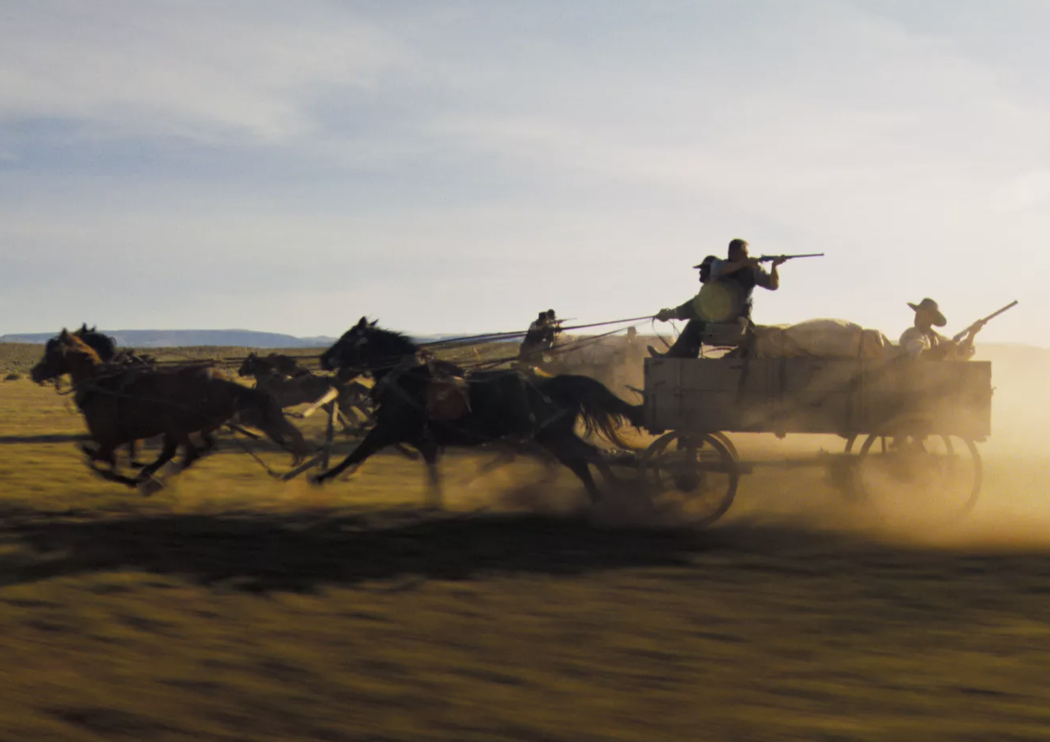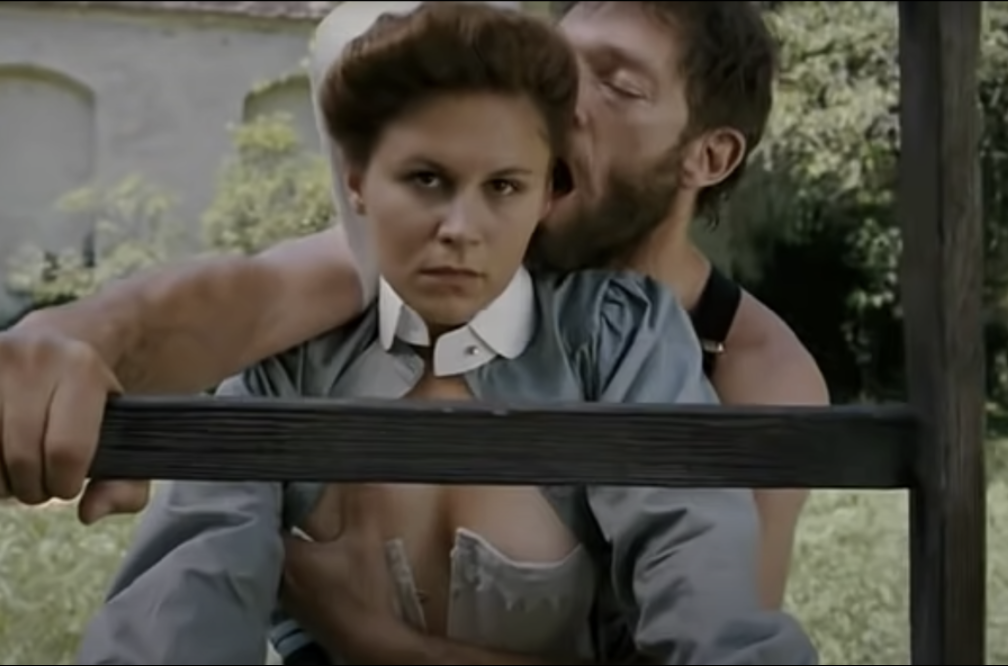While Tapping…
…out a lead piece about Jim Jarmusch’s Broken Flowers, which everyone saw at this morning’s 8:30 am press screening (and which will have its black-tie premiere tonight), I may as well put up these photos from the post-screening press conference, which ended a bit after 12 noon.
I respected and mostly liked Broken Flowers, bit I didn’t find it entirely sublime. It felt a bit under-fueled and sketchy at times, but that’s Jarmusch for you…he likes his characters…his movies, I mean…cut and dried without any of that emotional backstory stuff.
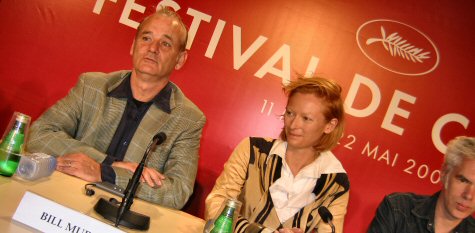
Broken Flowers star Bill Murray, costar Tilda Swinton and (half cropped) director-writer Jim Jarmusch.
Broken Flowers is actually fairly penetrating. It’s a dryly intriguing comedy about a middle-aged lonely guy (Bill Murray) flying around the country and trying to figure out which old girlfriend has written him a note telling him he has a 19 year-old son.
Mostly it’s about loneliness and regret and missed opportunities, and is one of those films that gets better the more you mull it over. I saw it about four hours ago and it’s growing on me already. I liked that it doesn’t fill in all the blanks or neatly tie things up at the finish.
< ?php include ('/home/hollyw9/public_html/wired'); ?>
It has, of course, Jarmusch’s signature elements (minimalism, understatement, observings of cultural minutae), and a somewhat taciturn, occasionally hilarious lead performance by Bill Murray.
Anyway, I’ll expand on this in a little, and in the meantime here are some more press conference photos, plus a shot of Jarmsuch taken yesterday (Monday, 5.16) at a Fortissimo Films party at the Noga Hilton beach annex:
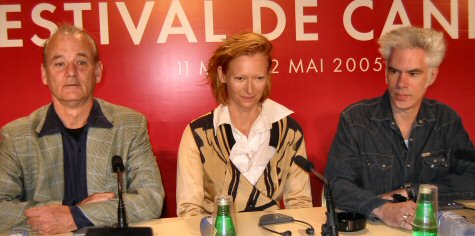
Broken Flowers stars Murray and Swinton, director-writer Jim Jarmusch.

Jim Jarmusch — Monday, 5.16.05, 7:55 pm.
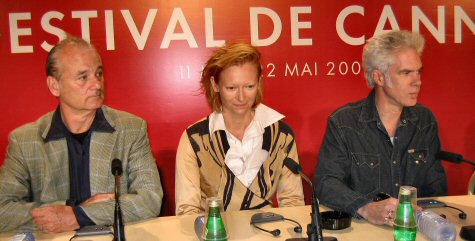
Plantation Blues
Manderlay didn’t do it for me, and I’m speaking as a totally ardent fan of von Trier’s Dogville , Dancer in the Dark and Breaking the Waves, as well as a general fool for his bad-boy provocateur routine.
It’s a relentlessly talky, intelligent and provocative film that addresses..,well, American racism, certainly, but more generally a do-gooder tendency by American governments to try and shape other societies so they more resemble our own (Iraq, Vietnam, etc.). And it indulges in the usual proddings and agitations that are par for this Danish filmmaker.
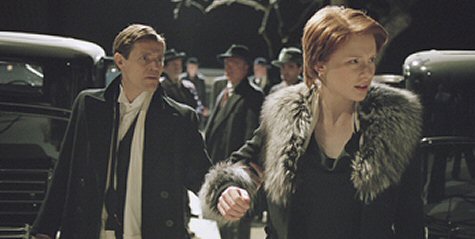
Willem Dafoe and Bryce Dallas Howard in opening scene from Lars von Trier’s Manderlay.
I don’t know when it’ll open in the States, but I’m presuming Manderlay wi ll piss off African-Americans when it opens there for saying, in part, that they are playing (or have played) a willing part in their economic subjugation by whites.
The second installment in von Trier’s America, Manderlay is a continuation of the adventures of Grace, the gangster’s daughter played by Nicole Kidman in Do gville, the trilogy’s 2003 kickoff, and by Bryce Dallas Howard in the new film.
Both films are stagey and pedantically inclined, and shot on what is probably the same massive sound stage with imaginary props and sets. (The third installment will presumably follow suit.)
Manderlay‘s problem is that it’s too similar to Dogville…and not similar enough.
Despite its slow pace and very gradual plot development, Dogville had a surprise character revelation (i.e., that Kidman is the daughter of gangster James Caan, and not his girlfriend, as the film allows us to assume at first) and a shockingly violent finale that expressed von Trier’s negative feelings about what he sees as American tendencies to exploit the less fortunate.
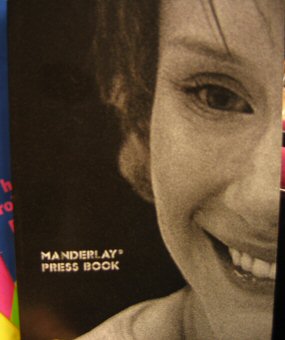
The perfect-bound, pocket book-sized press notes for Lars von Trier’s Manderlay.
Manderlay is supposed to walk, talk and feel like a Dogville companion. It is broken up by titled chapters, John Hurt again provides the dry and pungent narration, and the closing credit sequence is nearly identical with the same David Bowie song (“Young Americans”) played over a series of stills that il laminate the uglier aspects of America’s history – in this instance, the treatment of African-Americans over the last century or so.
But there’s no big jolt or surprise at the finale — you can pretty much tell what’s coming from the get-go – and it so closely recalls Dogville‘s aching-butt aspects that watching it feels like a chore.
Set in the early 1930s, some days or weeks after Dogville ended, Grace and her father (Willem Dafoe, taking over for James Caan) and his gang of thugs pull up out side the gates of an Alabama plantation called Manderlay.
To her shock, the na√É∆í√ǬØve and willful Grace quickly learns that slavery is still in place here — the black workers lorded over by a white family (which is headed by Lauren Bacall). She quickly decides to use her dad’s power to take over the plantation and institute democracy and free choice and self-sufficiency.
But the process of teaching is kind of fraught with contradictions. Grace needs to order and organize and put structure into place, and the black men and women of Manderlay resist or elude her plans in different ways, and old habits revive themselves and Grace gradually ends up becoming a tyrant — just like the slave-running family she replaced.
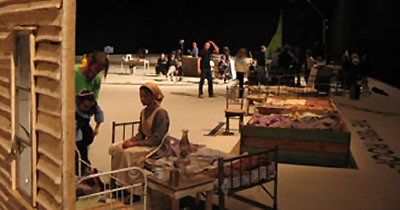
Manderlay‘s sound-stage set.
She develops the hots for a laborer named Timothy (Issach de Bankole) whom she first saw tied to a post and about to be whipped. She and Timothy eventually submit to their mutual libidinal urges, but he is tied up again by the end of the film and this time Grace is doing the whipping.
She also executes an older woman named Wilma (Mona Hammond) who, it is charged, was responsible for the starvation death of a child.
The bottom line is that Manderlay isn’t punchy or startling enough to justify the two hour and 19 minute running time.
Until Tomorrow…
I have to quit now, but here are some photos I took last night and today. I’m seeing Jim Jarmusch’s Broken Flowers, starring Bill Murray, tomorrow morning.
I meant to write about David Cronenberg’s A History of Violence, which I caught Sunday night and liked quite a lot, but I’ll have to get into it tomorrow also.

Viggo Mortenson in David Cronenberg’s smartly assembled, suprisingly amusing A History of Violence.
Viggo Mortensen stars as Tom Stall, a man who leads a quiet, small-town life with his wife (Maria Bello) and two kids. Then it turns out he’s a guy with a criminal past who’s adopted a fake name, and then some of the gangster types he ran with — dark-suited baddies from Philadelphia, including characters played by Ed Harris and William Hurt — start showing up and saying, “Heyyyy…”
I was especially turned around by the dark humor aspects. A lot of people get bloodied and shot and killed in this film, but it’s a very funny thing at times, and I wasn’t the only one feeling this way.
There was a French guy in the audience at the Salle de Bussy’s 7:30 pm showing who yelled at the audience while the film was running, saying,in effect, “Stop laughing…this isn’t funny!”
Randoms
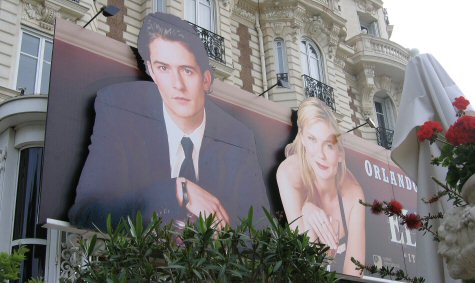
Carlton Hotel billboard for Cameron Crowe’s Elizabethtown.
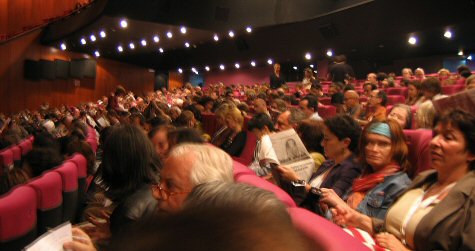
Audience at Salle de Bussy on Sunday evening, just before the lights went down and David Cronenberg’s A History of Violence began — Sunday, 5.15.05, 7:25 pm.
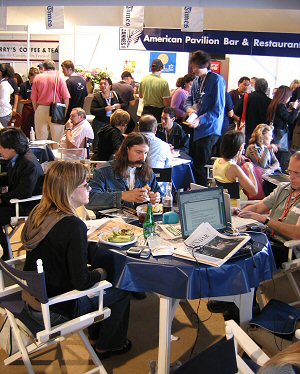
My work station (i.e., lower right, newspaper on keyborad) at the American Pavillion — Monday, 5.16.05, 1:55 pm.
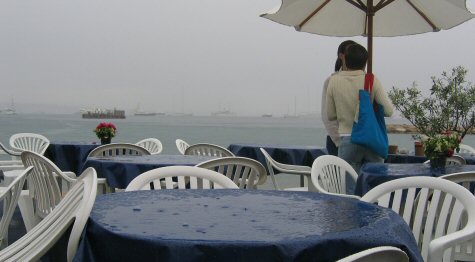
View of rainstorm from American Pavillion — Monday, 5.16.05, 2:40 pm.

London filmmaker Natalie Turner (Sfumato), Channel 4 journalist-critic Annette Dasey at Sunday night’s Star Wars party — 5.16.05, 12:20 am.
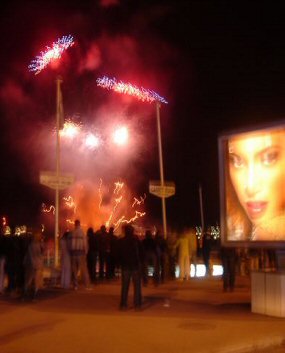
Fireworks over baie de Cannes — Sunday, 5.15.05, 11:40 pm.
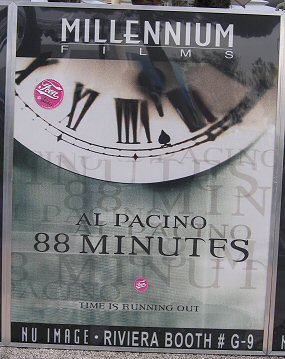
Death Stars
George Lucas and his digital galactic posse arrived in Cannes Sunday
(5.15), and attracted, to no one’s surprise, more attention than any other film or team of filmmakers who’ve dropped by thus far.
Which is symmetrically appropriate, I suppose, since we all realize that Stars Wars: Episode 3 — Revenge of the Sith will most likely attract more ticket buyers than probably all the other films showing here (including the market offerings) combined.
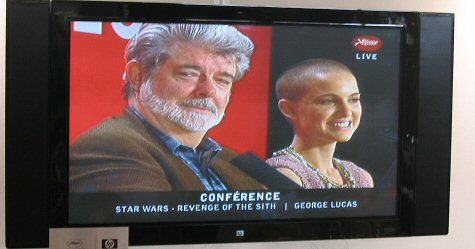
Star Wars: Episode 3 – Revenge of the Sith director-writer George Lucas and costar Natalie Portman during Sunday afternoon’s Cannes Film Festival press conference, which I would have attended if I didn’t have better things to do — 5.15.05, 1:10 pm.
There’s no percentage in being a sorehead and teeing off on George and his unstoppably mediocre film all over again, so let’s just zip it.
The Sith press conference, which just ended about 20 minutes ago (i.e., at 2 pm), was a two-toned affair — the occasional (make that very occasional) journalist asking a somewhat pointed question and Lucas not really answering them, and the other journos asking puffball questions.
Big surprise, right? The world wants to love this film, publishers and editors who employ Cannes-covering journalists know this and just want the standard oooh-ahhh coverage, and who gives a hoot anyway?
Movie City News and Film Stew contributor Sperling Reich asked Lucas why he had made it more difficult for websites and bloggers in recent years to cover Star Wars-related news by not affording them the same access given to print publications. Lucas ignored the question and spoke about his love for the free exchange of information that the internet provides, etc. And Reich didn’t follow up.

I was standing by a big window overlooking the path that Team Lucas (Hayden Christensen, Rick McCallum, Portman, Samuel L. Jackson, etc.) were about to walk by, and I was going to snap a photo when one of the Wi-Fi Cafe volunteers (i.e., French girls in their early 20s dressed in white T-shirts and white ass-hugging pants) said no pictures, per order of some festival bigwig.
I put my camera away but donnez-moi un fucking break.
The 20th Century Fox publicity people gave me tickets to the Sunday night after-party, which is classy of them given my general animus, etc.
Saturday Afternoon

Bob Berney, head of the newly formed Picturehouse, the newly-formed HB0 and New Line-backed indie distribution company, and wife Jeanne Berney (who’s on a temporary hiatus from publicity chores) at beachside party celebrating the company’s launch — Saturday, 5.14, 5:35 pm

Chicago Tribune reporter Jackie Fitzgerald (far left), film critic Michael Wilmington and Where the Truth Lies director Atom Egoyan (right) at Picturehouse launch party — Saturday, 5.14.05, 6:20 pm.
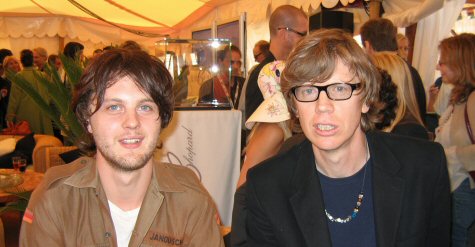
Last Days star Michael Pitt (l.), Sonic Youth’s Thurston Moore at Picturehouse party — Saturday, 5.14.05, 6:47pm.
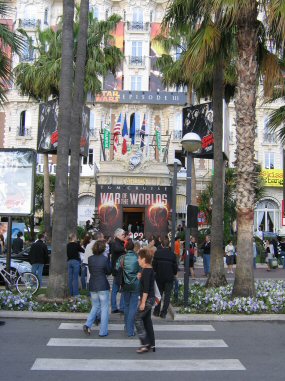
.
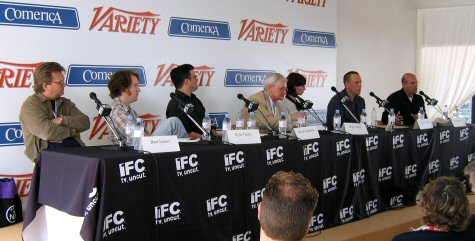
During Variety-sponsored panel discussion among American directors: (l. to r.) Brent Hamer (Factotum), Kyle Henry (Room), David Jacobson (Down in the Valley), host Roger Ebert, Miranda July (Me and You and Everyone We Know), Lodge Kerrigan (Keane) and Stuart Sammuels (Midnight Movies: From the Margin to the Mainstream).
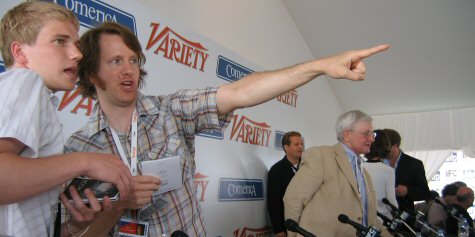
Room director Kyle Henry (sideburns, facial blemish, second from left); panel host Roger Ebert slightly behind and to the right — Saturday, 5.14.05, 4:05 pm.
No Worries
I saw about an hour’s worth of Joyeux Noel at the Salle Bazin earlier today. That’s right — it wasn’t good enough to see through to the end.
It’s a French-produced period drama about the World War I Christmas truce of 1914, written and directed by Christian Clarion. It suffers from a too-modest budget, simplistic writing, the worst dubbing of an actor and actress pretending to be opera singers I’ve ever seen in my life, and a generally sentimental and ham-fisted tone that will almost certainly not play with audiences in the States, if any US distributor is reckless enough to pick it up.
As regular readers know, I ran a piece a few months ago about two other films being planned about this exact same subject.
Vadim Perlman (House of Sand and Fog) is (or was) planning a film called Truce, working from a script by Stuart Beattie. Paul Weitz and his brother Chris have been talking about making a film called Silent Night…exact same deal.
What I’m saying, obviously, is that Perlman and Weitz have only each other to fear…if their respective projects are still on the rails and moving ahead, I mean (which I’m not sure about at this stage).












